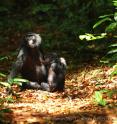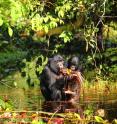Flexible vocalizations in wild bonobos show similarities to development of human speech
Related images
(click to enlarge)
From an early age, human infants are able to produce vocalisations in a wide range of emotional states and situations - an ability felt to be one of the factors required for the development of language. Researchers have found that wild bonobos (our closest living relatives) are able to vocalize in a similar manner. Their findings challenge how we think about the evolution of communication and potentially move the dividing line between humans and other apes. Animal vocalisations are usually made in relatively narrow behavioural contexts linked to emotional states, such as to express aggressive motivation or to warn about potential predators. In contrast, humans exhibit 'functional flexibility' when vocalizing in a variety of situations.
Researchers from the University of Birmingham, UK and the University of Neuchatel, Switzerland, conducted research on wild bonobos and found that in this species individuals produce a call type, known as the 'peep', across a range of positive, negative and neutral situations, such as during feeding, travel, rest, aggression, alarm, nesting and grooming. Peeps are high-pitched vocalisations which are short in duration and produced with a closed mouth.
They found broad similarity in the acoustic structure across different contexts suggesting contextual flexibility in this call. Similar to human infants, recipients therefore have to make pragmatic inferences about the meaning of this call across contexts.
Author Zanna Clay said that the findings show that "more research needs to be done on our great ape relatives before we can make conclusions about human uniqueness. The more we look, the more continuity we find among animals and humans"
The type of functional flexibility they observed in bonobos could represent an important evolutionary transition from functionally fixed animal vocalisations towards flexible human vocalisations, which seems to have appeared some 6-10 million years ago in the shared common ancestor between humans and great apes. It appears that many of the core features of human language have deep roots in the primate lineage.
Source: PeerJ
Articles on the same topic
- New study shows how complex bonobo communication is similar to that of human infantsTue, 4 Aug 2015, 18:32:12 UTC
Other sources
- Wild bonobo speech resembles human baby talkfrom UPITue, 4 Aug 2015, 18:40:19 UTC
- Going Ape: Bonobos Make Sounds Like That of Human Babiesfrom MSNBC: ScienceTue, 4 Aug 2015, 18:30:21 UTC
- Flexible vocalizations in wild bonobos show similarities to development of human speechfrom Science DailyTue, 4 Aug 2015, 13:30:10 UTC
- Bonobos' clue to speech evolutionfrom BBC News: Science & NatureTue, 4 Aug 2015, 12:30:15 UTC
- New study shows how complex bonobo communication is similar to that of human infantsfrom PhysorgTue, 4 Aug 2015, 11:30:14 UTC

